Experimental and Numerical Studies of Self-Expansible Polyurethane Slurry Diffusion Behavior in a Fracture Considering the Slurry Temperature
Abstract
:1. Introduction
2. Test Studies
2.1. Test Materials
2.2. Test Device and Procedure
2.3. Test Results and Analysis
3. Method of Chemical Reaction-Fluid Dynamic Model
3.1. Chemical Reaction Kinetic Equation
3.2. Chemical Reaction Kinetic Parameter Identification
3.3. Density Equation
3.4. Polymer Flowing Control Equation
3.5. Heat Conduction Equation of the Fracture Wall
4. Solution of CF Model
4.1. Discretization of the Momentum and Energy Conservation Equation
4.2. The SIMPLE Algorithm
4.3. Discretization of the Heat Conduction Equation for Fracture Walls
5. Numerical Simulation
5.1. Model Description
5.2. Basic Assumptions
- The slurry is an isotropic, homogeneous, continuous fluid;
- The slurry is in a laminar flow state during the reaction process;
- The fracture planar surface is rigid. It will not deform due to the grout pressure during the diffusion process.
5.3. Numerical Simulation Result and Verification
5.3.1. Diffusion Radius
5.3.2. Polymer Temperature
5.3.3. Polymer Density
6. Discussion of the Influence of Temperature
7. Conclusions
- Under the same ambient temperature conditions, as the slurry preheating temperature increases, the reaction rate, diffusion rate, and heating rate of the slurry increase, and the slurry peak temperature increases, reaching the peak point earlier.
- Under the same preheating temperature conditions, the higher the ambient temperature, the faster the slurry diffusion rate and the larger the diffusion radius. When the preheating temperature of the slurry increases to a certain value, the final diffusion range of the slurry no longer changes significantly.
Author Contributions
Funding
Institutional Review Board Statement
Informed Consent Statement
Data Availability Statement
Acknowledgments
Conflicts of Interest
References
- Lei, Q.H.; Latham, J.P.; Xiang, J.S.; Tsang, C.F. Role of natural fractures in damage evolution around tunnel excavation in fractured rocks. Eng. Geol. Geol. 2017, 231, 100–113. [Google Scholar] [CrossRef]
- Fidelibus, C.; Lenti, V. The propagation of grout in pipe networks. Comput. Geosci. 2012, 45, 331–336. [Google Scholar] [CrossRef]
- Funehag, J.; Fransson, A. Sealing narrow fractures with a Newtonian fluid: Model prediction for grouting verified by field study. Tunn. Undergr. Space Technol. 2006, 5, 492–498. [Google Scholar] [CrossRef]
- Hu, S.; Liu, Q.; Li, S.; Sang, H.; Kang, Y. Advance and review on grouting critical problems in fractured rock mass. Coal Sci. Technol. 2022, 1, 112–126. [Google Scholar]
- Liu, J.; Liu, R.; Zhang, X.; Li, S. Diffuson law model test and numerical simulation of cement farcture grouting. Chin. J. Rock Mech. Eng. 2012, 12, 2445–2452. [Google Scholar]
- Mito, Y.; Ashraf, M.; Yamamoto, T. Numerical modeling for the evaluation of grout penetration in fractured rock masses. In Proceedings of the 12th ISRM International Congress on Rock Mechanics, Beijing, China, 17–21 October 2011; pp. 483–486. [Google Scholar]
- Oliveir, D.; Diederichs, M.S. Tunnel support for stress induced failures in Hawkesbury Sandstone. Tunn. Undergr. Space Technol. 2017, 64, 10–23. [Google Scholar] [CrossRef]
- Sha, F.; Lin, C.J.; Li, Z.F.; Liu, R.T. Reinforcement simulation of water-rich and broken rock with Portland cement-based grout. Constr. Build. Mater. 2019, 221, 292–300. [Google Scholar] [CrossRef]
- Li, S.C.; Liu, R.T.; Zhang, Q.S.; Zhang, X. Protection against water or mud inrush in tunnels by grouting: A review. J. Rock Mech. Geotech. Eng. 2016, 5, 14. [Google Scholar] [CrossRef]
- Yuan, S.C.; Sun, B.T.; Han, G.L.; Duan, W.Q.; Wang, Z.X. Application and prospect of curtain grouting technology in mine water safety management in China: A review. Water 2022, 14, 4093. [Google Scholar] [CrossRef]
- Jin, L.C.; Sui, W.H. Experimental investigation on chemical grouting in rough 2D fracture network with flowing water. Bull. Eng. Geol. Environ. 2021, 80, 8519–8533. [Google Scholar] [CrossRef]
- Wang, Y.H.; Yang, P.; Li, Z.T.; Wu, S.J.; Zhao, Z.X. Experimental-numerical investigation on grout diffusion and washout in rough rock fractures under flowing water. Comput. Geotech. 2020, 126, 103717. [Google Scholar] [CrossRef]
- Draganovic, A.; Stille, H. Filtration of cement-based grouts measured using a long slot. Tunn. Undergr. Space Technol. 2014, 43, 101–112. [Google Scholar] [CrossRef]
- Mohammed, M.H.; Pusch, R.; Knutsson, S. Study of cement-grout penetration into fractures under static and oscillatory conditions. Tunn. Undergr. Space Technol. 2015, 45, 10–19. [Google Scholar] [CrossRef]
- Sui, W.H.; Liu, J.Y.; Hu, W.; Qi, J.F.; Zhan, K.Y. Experimental investigation on sealing efficiency of chemical grouting in rock fracture with flowing water. Tunn. Undergr. Space Technol. 2015, 50, 239–249. [Google Scholar] [CrossRef]
- Yang, P.; Li, T.B.; Song, L.; Deng, T.; Xue, S.B. Effect of different factors on propagation of carbon fiber composite cement grout in a fracture with flowing water. Constr. Build. Mater. 2016, 121, 501–506. [Google Scholar] [CrossRef]
- Funehag, J.; Thorn, J. Radial penetration of cementitious grout-Laboratory verification of grout spread in a fracture model. Tunn. Undergr. Space Technol. 2018, 72, 228–232. [Google Scholar] [CrossRef]
- Li, Z.; Liu, H.X.; Dun, Z.L.; Ren, L.W.; Fang, J.J. Grouting effect on rock fracture using shear and seepage assessment. Constr. Build. Mater. 2020, 242, 118131. [Google Scholar] [CrossRef]
- Wallner, M. Propagation of sedimentation stable cement pastes in jointed rock. Rock Mech. Waterw. Constr. 1977, 14, 14. [Google Scholar]
- Hassler, L.; Hakansson, U.; Stille, H. Computer-Simulated Flow of Grouts in Jointed Rock. Tunn. Undergr. Space Technol. 1992, 4, 441–446. [Google Scholar] [CrossRef]
- Eriksson, M.; Stille, H.; Andersson, J. Numerical calculations for prediction of grout spread with account for filtration and varying aperture. Tunn. Undergr. Space Technol. 2000, 4, 353–364. [Google Scholar] [CrossRef]
- Yang, M.J.; Yue, Z.Q.; Lee, P.K.K.; Su, B.; Tham, L.G. Prediction of grout penetration in fractured rocks by numerical simulation. Can. Geotech. J. 2002, 6, 1384–1394. [Google Scholar] [CrossRef]
- Luo, P.; Zhu, Y.; Zhao, Y.; He, S. Numerical simulation of grouting in rock mass. Chin. J. Geotech. Eng. 2005, 8, 918–921. [Google Scholar]
- Saeidi, O.; Stille, H.; Torabi, S.R. Numerical and analytical analyses of the effects of different joint and grout properties on the rock mass groutability. Tunn. Undergr. Space Technol. 2013, 38, 11–25. [Google Scholar] [CrossRef]
- Zhou, L.; Su, K.; Wu, H.G.; Shi, C.Z. Numerical Investigation of Grouting of Rock Mass with Fracture Propagation Using Cohesive Finite Elements. Int. J. Geomech. 2018, 7, 04018075. [Google Scholar] [CrossRef]
- Xu, Y.; Peng, W.H. Research on Multiple Holes Grouting of Fractured Rock Mass. In Proceedings of the 2nd International Conference on Civil Engineering and Transportation (ICCET 2012), Guilin, China, 27–28 October 2012; pp. 547–551. [Google Scholar]
- Mohajerani, S.; Baghbanan, A.; Bagherpour, R.; Hashemolhosseini, H. Grout penetration in fractured rock mass using a new developed explicit algorithm. Int. J. Rock Mech. Min. Sci. 2015, 80, 412–417. [Google Scholar] [CrossRef]
- Oge, I.F. Prediction of cementitious grout take for a mine shaft permeation by adaptive neuro-fuzzy inference system and multiple regression. Eng. Geol. 2017, 228, 238–248. [Google Scholar] [CrossRef]
- Dehghanipoodeh, M.; Baghbanan, A.; Hashemolhosseini, H.; Laghaei, M.; Salimian, M.H. Investigating the deformability of grouted rock mass under static and dynamic loading conditions. Bull. Eng. Geol. Environ. 2019, 6, 4549–4566. [Google Scholar] [CrossRef]
- Zhu, G.X.; Zhang, Q.S.; Lin, X.; Liu, R.T.; Zhang, L.Z.; Zhang, J.W. Analysis of the Sealing Mechanism of Cement-Sodium Silicate Grout in Rock Fractures with Flowing Water. Water 2020, 7, 1935. [Google Scholar] [CrossRef]
- Li, S.C.; Pan, D.D.; Xu, Z.H.; Lin, P.; Zhang, Y.C. Numerical simulation of dynamic water grouting using quick-setting slurry in rock fracture: The Sequential Diffusion and Solidification (SDS) method. Comput. Geotech. 2020, 122, 103497. [Google Scholar] [CrossRef]
- Li, X.L.; Hao, M.M.; Zhong, Y.H.; Zhang, B.; Wang, F.M.; Wang, L.B. Experimental study on the diffusion characteristics of polyurethane grout in a fracture. Constr. Build. Mater. 2021, 273, 121711. [Google Scholar] [CrossRef]
- Shi, M.S.; Wang, F.M.; Luo, J. Compressive Strength of Polymer Grouting Material at Different Temperatures. J. Wuhan Univ. Technol.-Mater. Sci. Ed. 2010, 25, 962–965. [Google Scholar] [CrossRef]
- Li, X.L.; Wang, L.B.; Hao, M.M.; Zhong, Y.H.; Zhang, B. An analytical solution for the radial flow of variable density grout in rock fractures. Constr. Build. Mater. 2019, 206, 630–640. [Google Scholar] [CrossRef]
- Hao, M.M.; Li, X.L.; Zhong, Y.H.; Zhang, B.; Jin, D.; Chen, G.G. Numerical simulation of polymer grout diffusion in a single fracture. AIP Adv. 2018, 10, 105329. [Google Scholar] [CrossRef]
- Li, X.; Zhang, T.; Wang, F.; Zhong, Y.; Zhang, B. Application of Youngs method in tracking the moving interface of expansible grout. Rock Soil Mech. 2017, 12, 3491–3497, 3504. [Google Scholar]
- Liang, J.S.; Du, X.M.; Fang, H.Y.; Du, M.R.; Shi, M.S.; Gao, X.L.; Han, Y.H. Numerical and experimental study of diffusion law of foamed polymer grout in fracture considering viscosity variation of slurry. Tunn. Undergr. Space Technol. 2022, 128, 104674. [Google Scholar] [CrossRef]
- Shi, M.; Xia, W. Experimental research on curing temperature of polyurethane polymer. New Chem. Mater. 2014, 7, 133–135. [Google Scholar]
- Meimei, H. Study on the Diffusion Law of Expansible Polymer Grout in the Water-Filled Rock Mass Fracture. Ph.D. Thesis, Zhengzhou University, Zhengzhou, China, 2019. [Google Scholar]
- Geier, S.; Winkler, C.; Piesche, M. Numerical Simulation of Mold Filling Processes with Polyurethane Foams. Chem. Eng. Technol. 2009, 9, 1436–1443. [Google Scholar] [CrossRef]
- Lipshitz, S.D.; Macosko, C.W. Kinetics and energetics of a fast polyurethane cure. J. Appl. Polym. Sci. 2010, 8, 2029–2039. [Google Scholar] [CrossRef]
- Seo, D.; Youn, J.R. Numerical analysis on reaction injection molding of polyurethane foam by using a finite volume method. Polymer 2005, 17, 6482–6493. [Google Scholar] [CrossRef]
- Tesser, R.; Di, S.; Sclafani, A.; Santacesaria, E. Modeling of polyurethane foam formation. J. Appl. Polym. Sci. 2004, 3, 1875–1886. [Google Scholar] [CrossRef]
- Ferkl, P.; Karimi, M.; Marchisio, D.L.; Kosek, J. Multi-scale modelling of expanding polyurethane foams: Coupling macro- and bubble-scales. Chem. Eng. Sci. 2016, 148, 55–64. [Google Scholar] [CrossRef]
- Karimi, M.; Marchisio, D.L. A Baseline Model for the Simulation of Polyurethane Foams via the Population Balance Equation. Macromol. Theory Simul. 2015, 4, 291–300. [Google Scholar] [CrossRef]
- Jia, H.Y.; Li, X.L.; Hao, M.M.; Li, Y.; Zhong, Y.H.; Zhang, B. Test Method for the Solubility Model of Physical Blowing Agent of Self-Expanding Polymer. Math. Probl. Eng. 2021, 2021, 5566754. [Google Scholar] [CrossRef]
- Baser, S.A.; Khakhar, D.V. Modeling of the Dynamics of R-11 Blown Polyurethane Foam Formation. Polym. Eng. Sci. 1994, 8, 632–641. [Google Scholar] [CrossRef]
- Baser, S.A.; Khakhar, D.V. Modeling of the Dynamics of Water and R-11 Blown Polyurethane Foam Formation. Polym. Eng. Sci. 1994, 8, 642–649. [Google Scholar] [CrossRef]
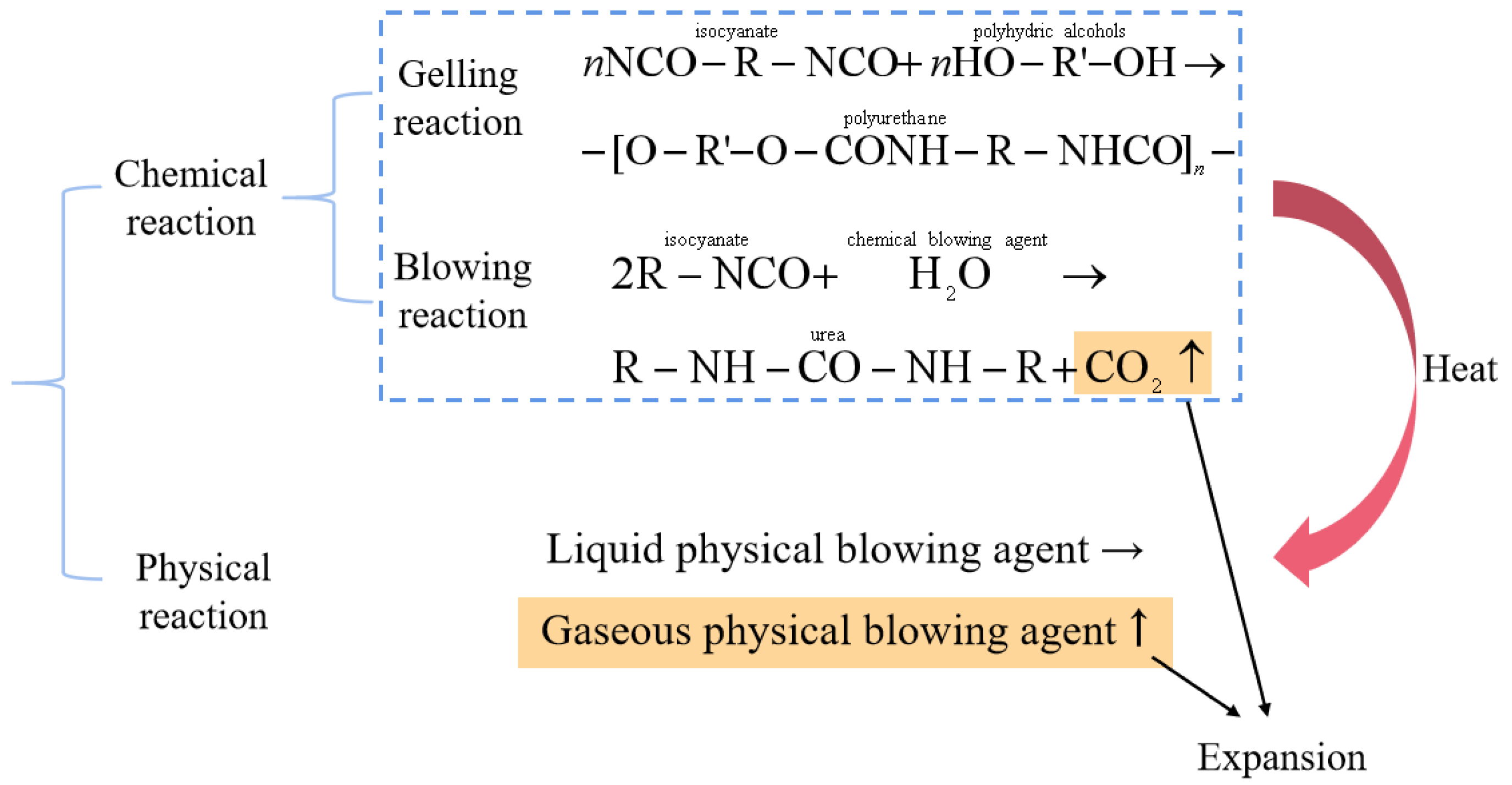

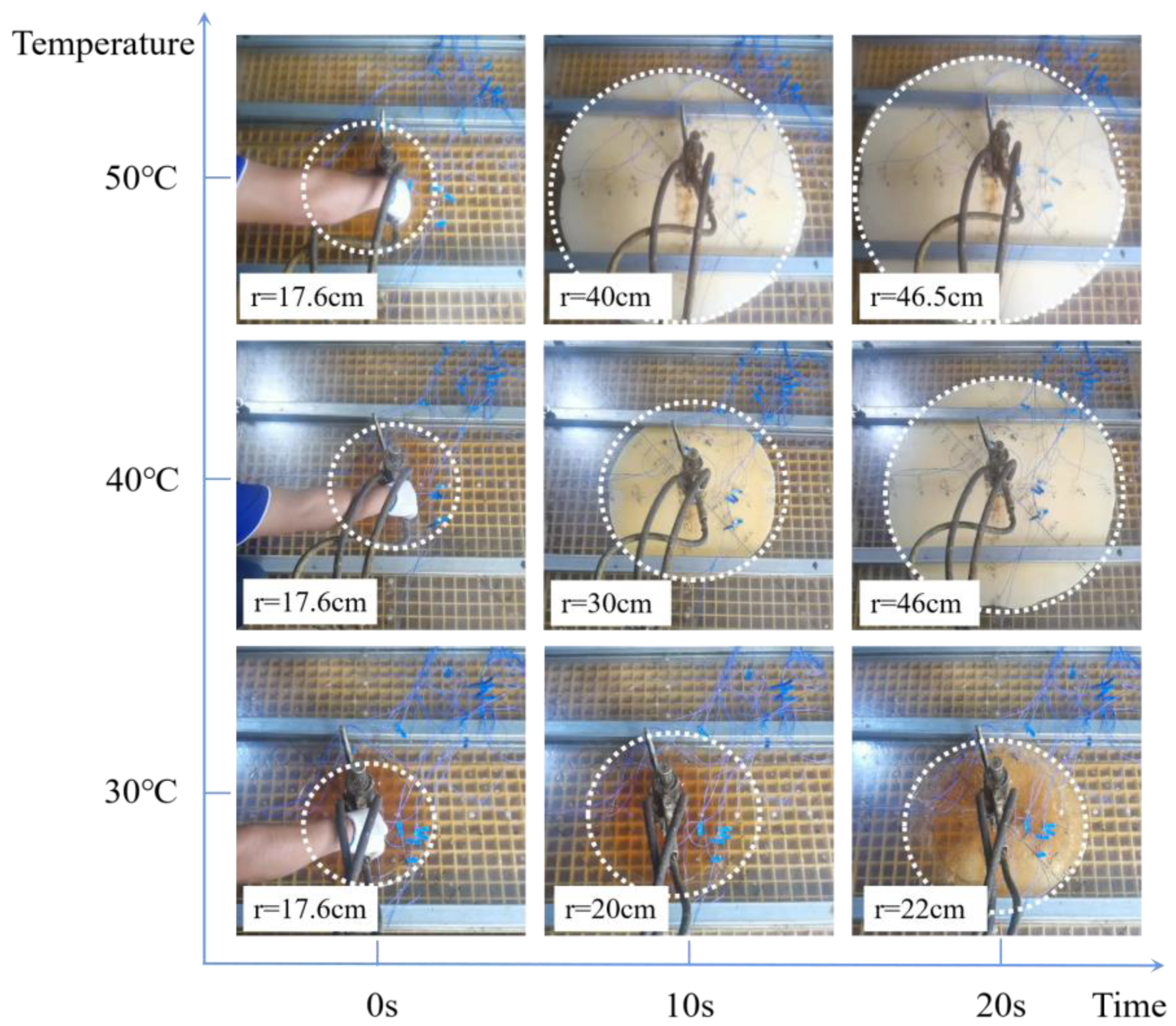
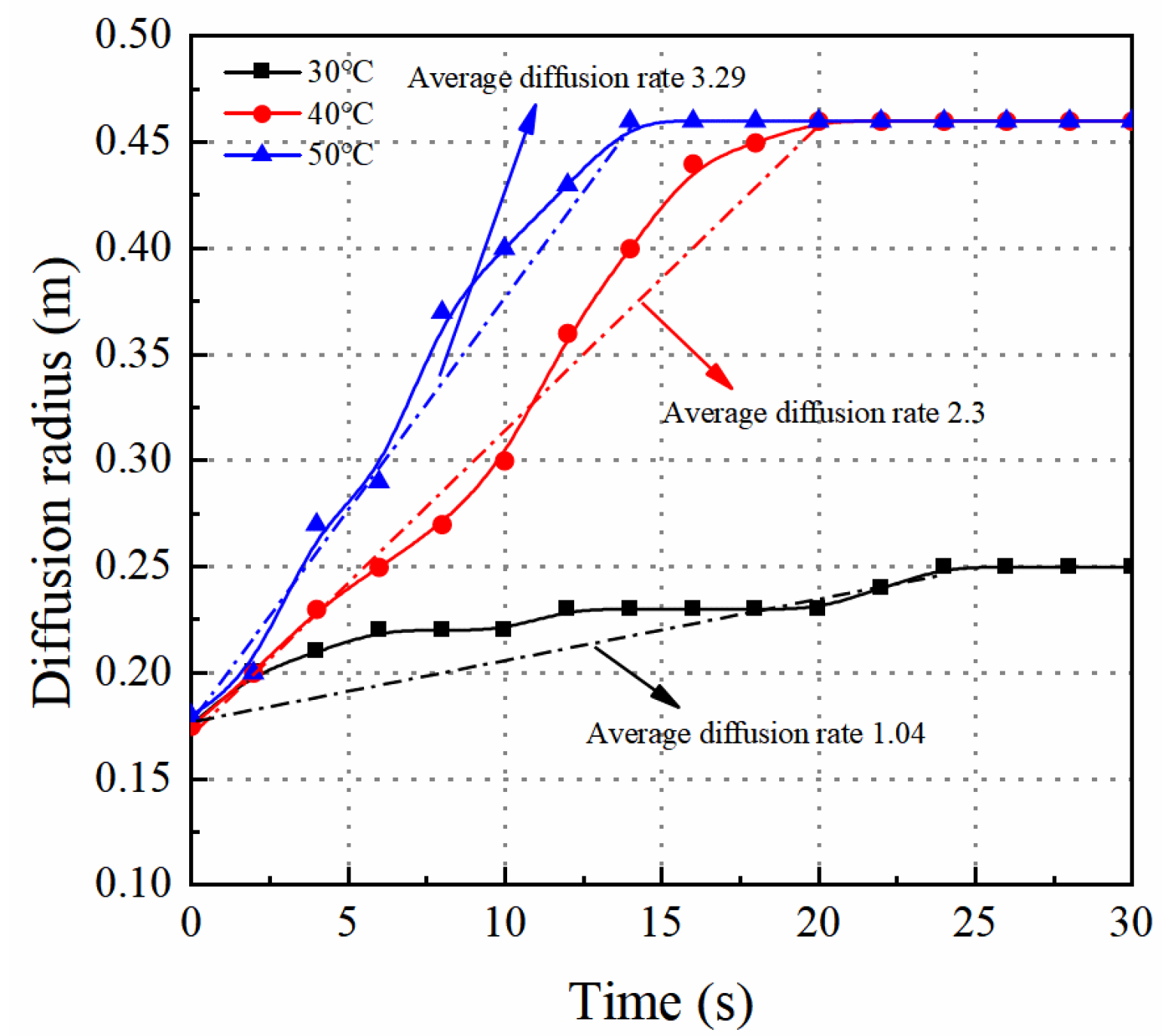

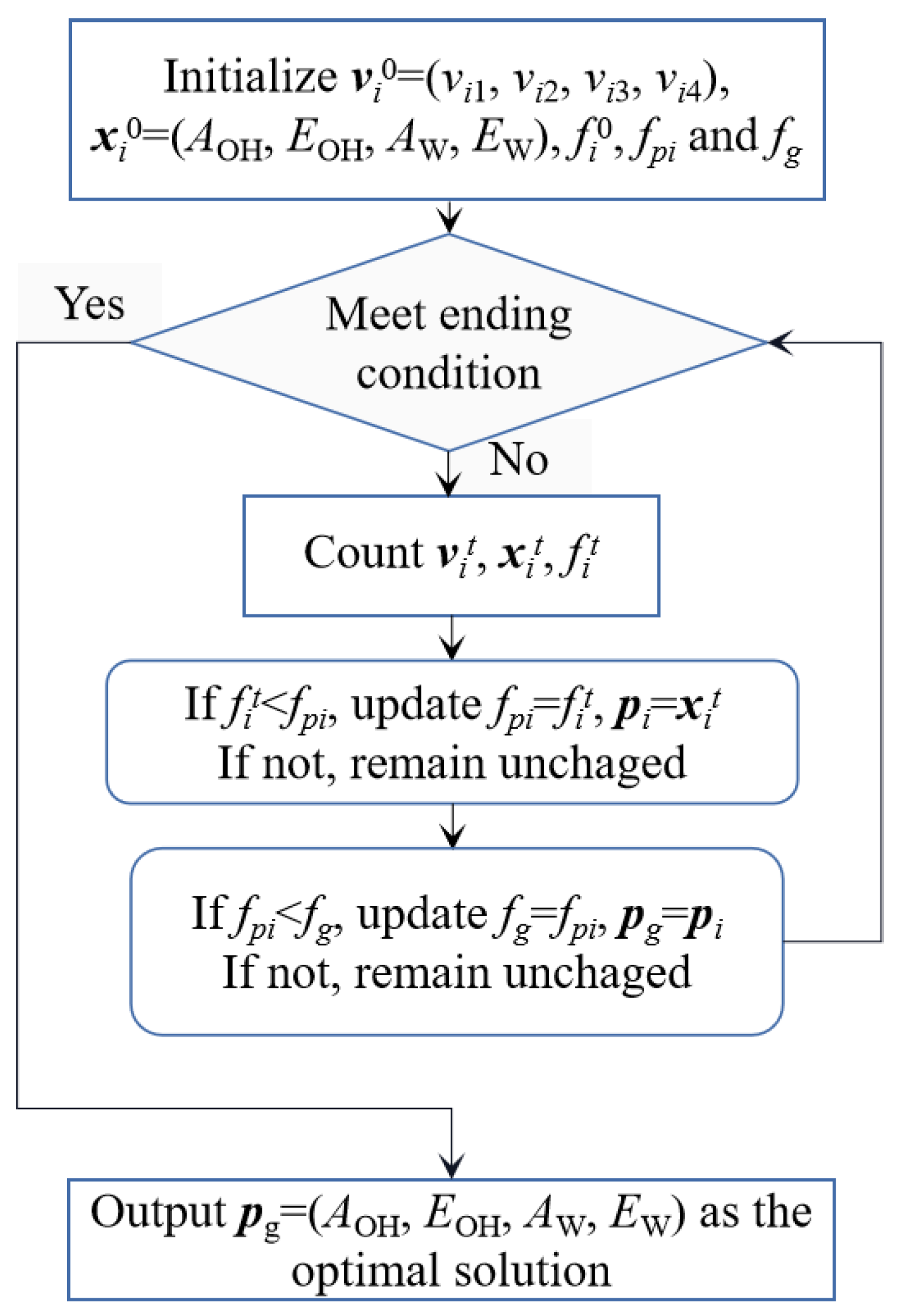
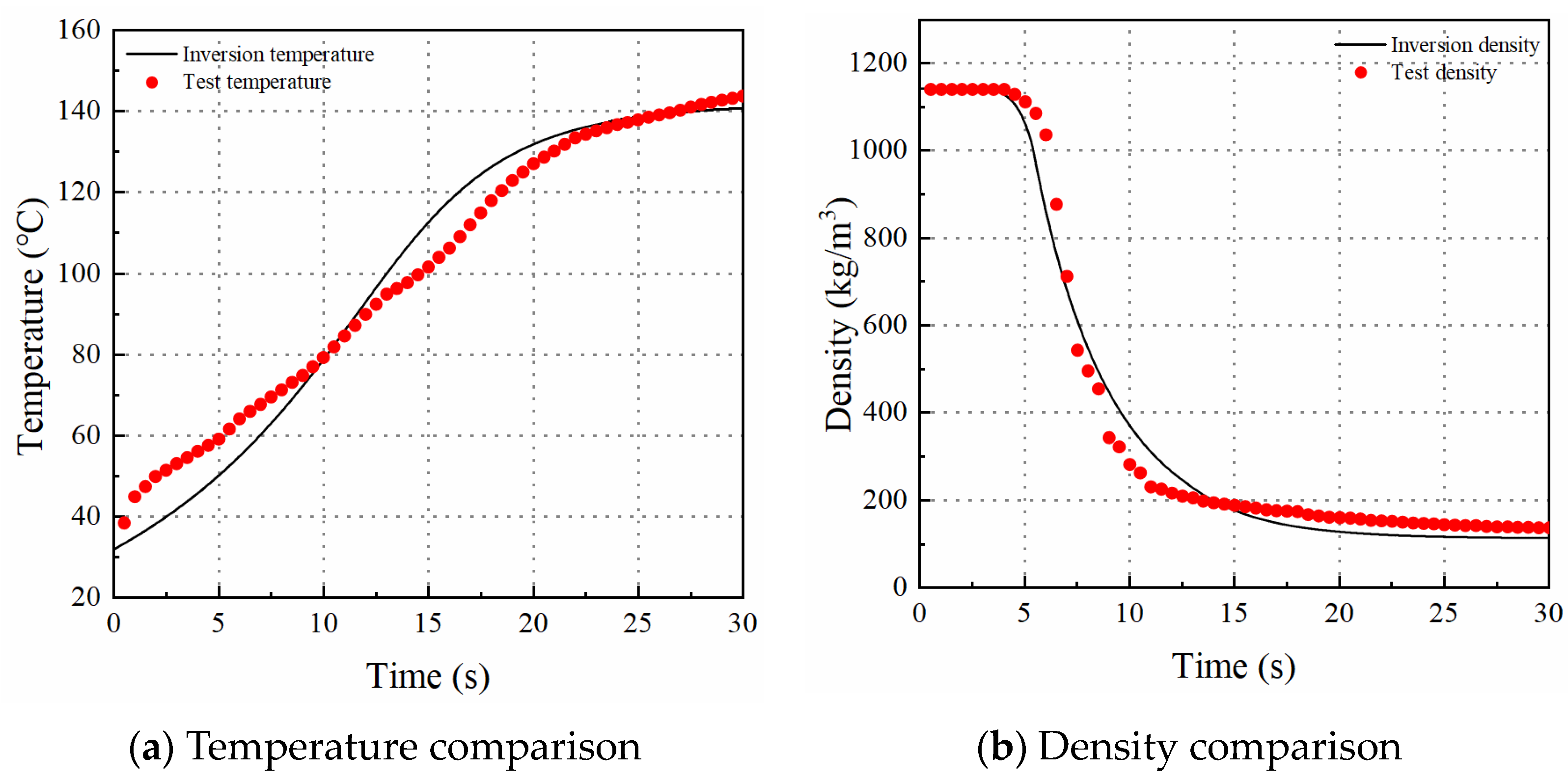
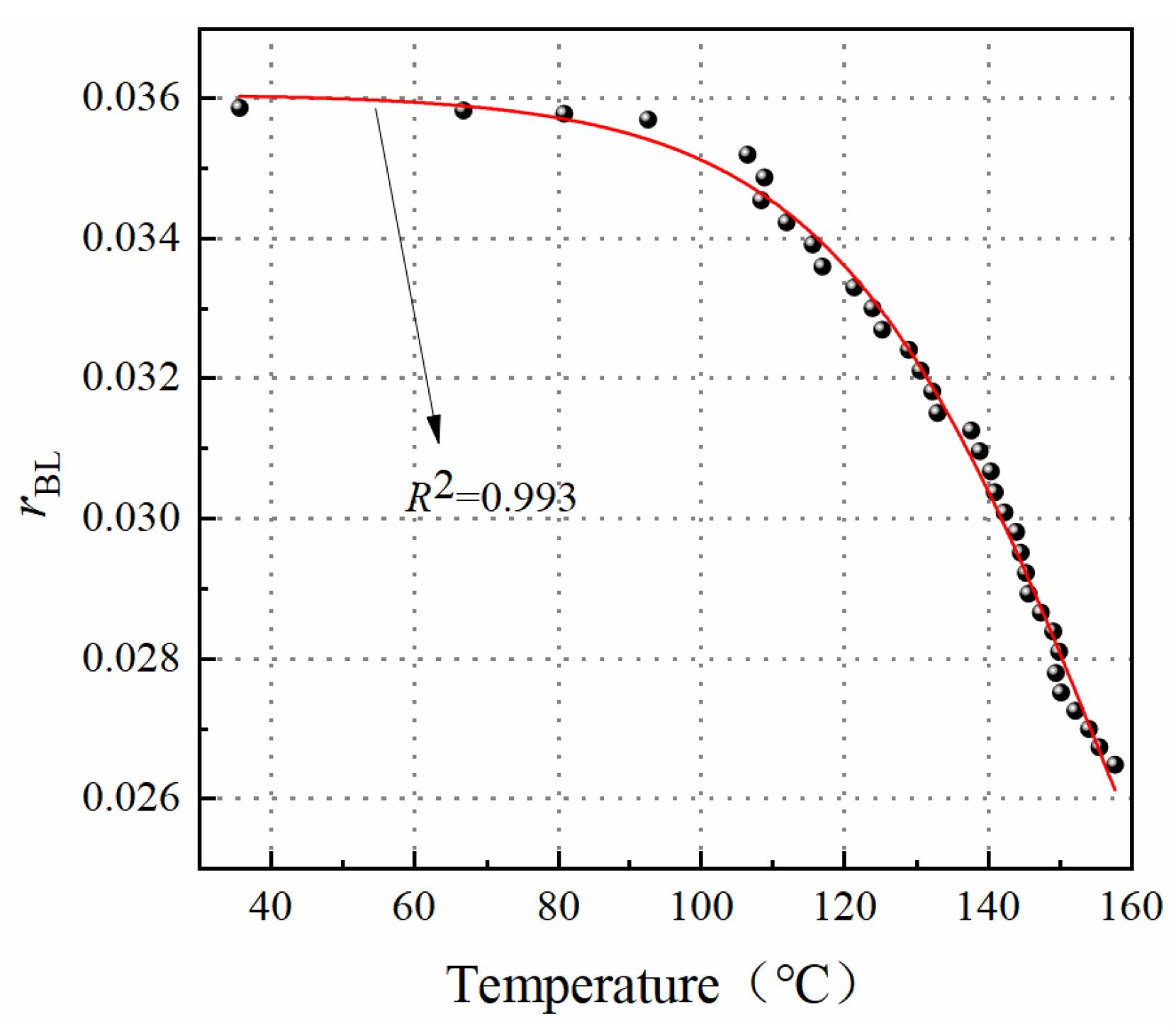
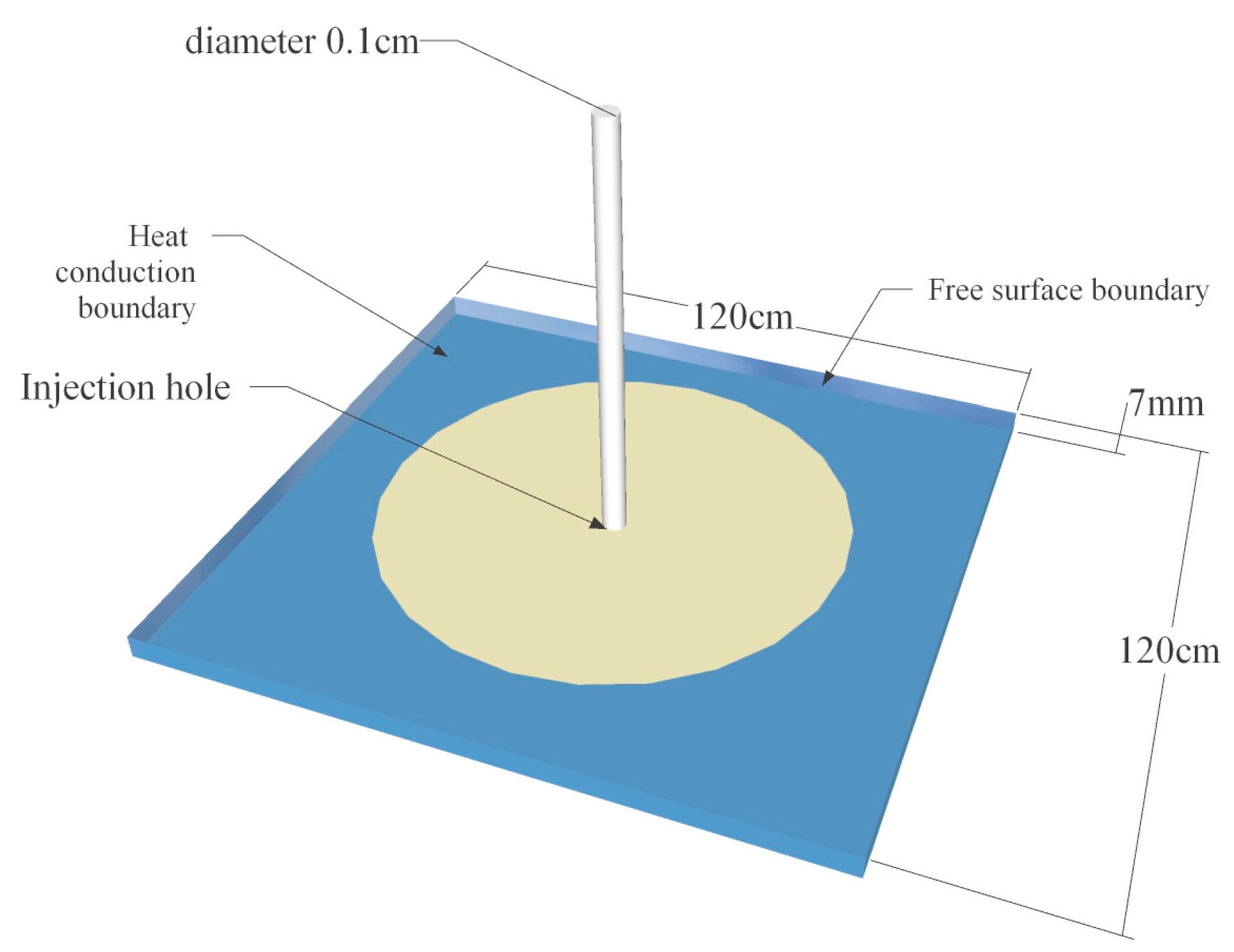
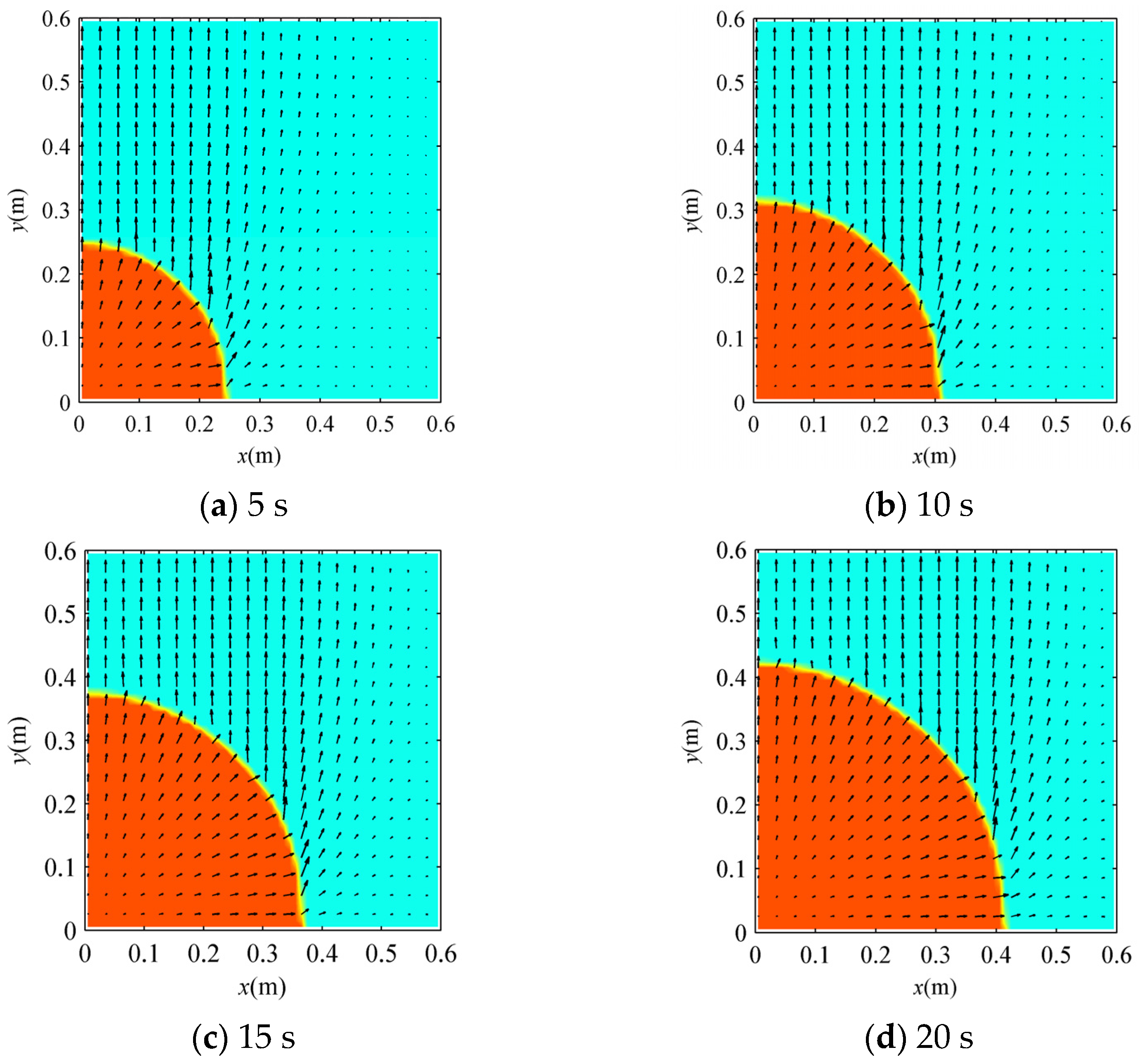

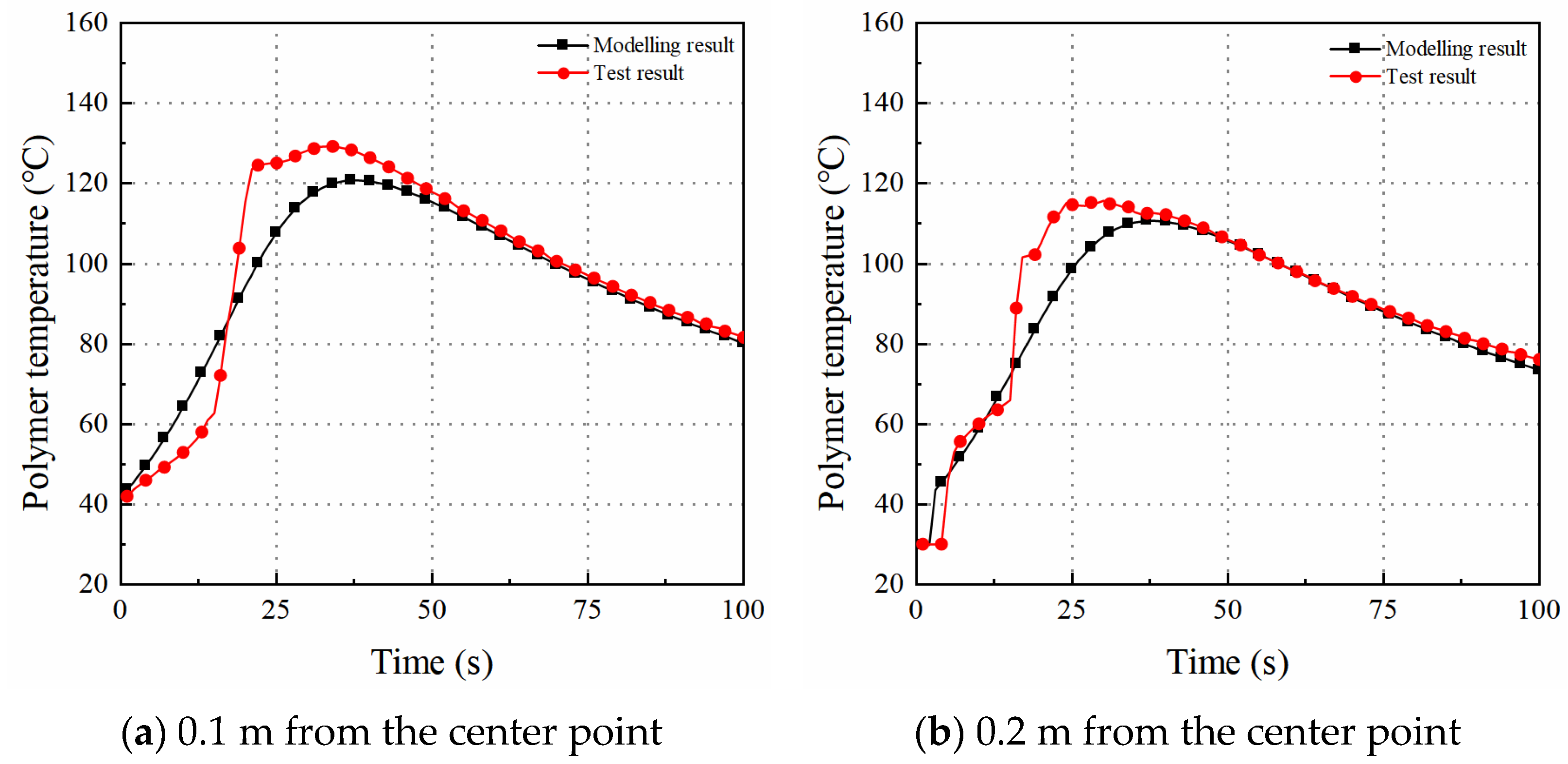
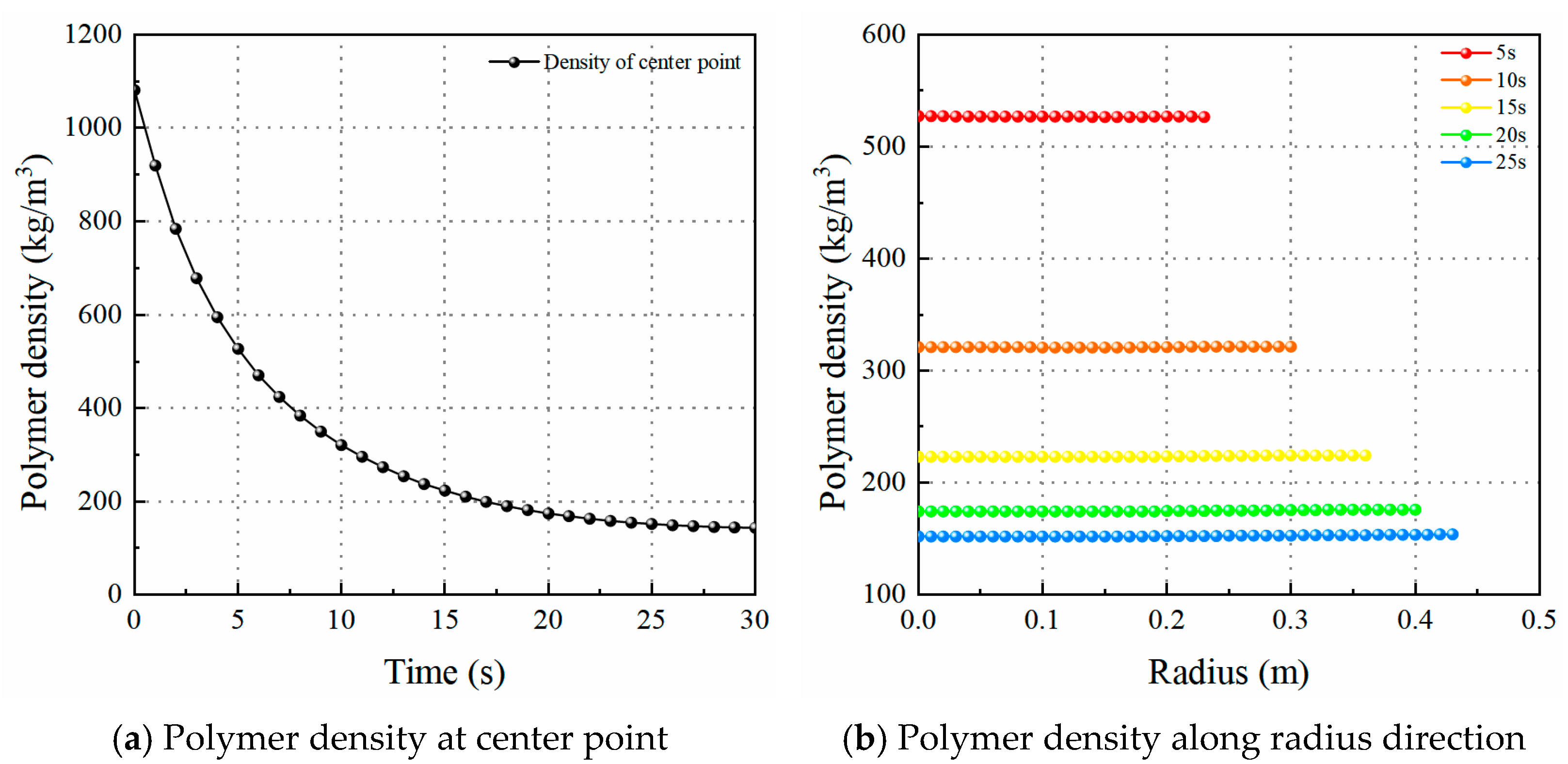

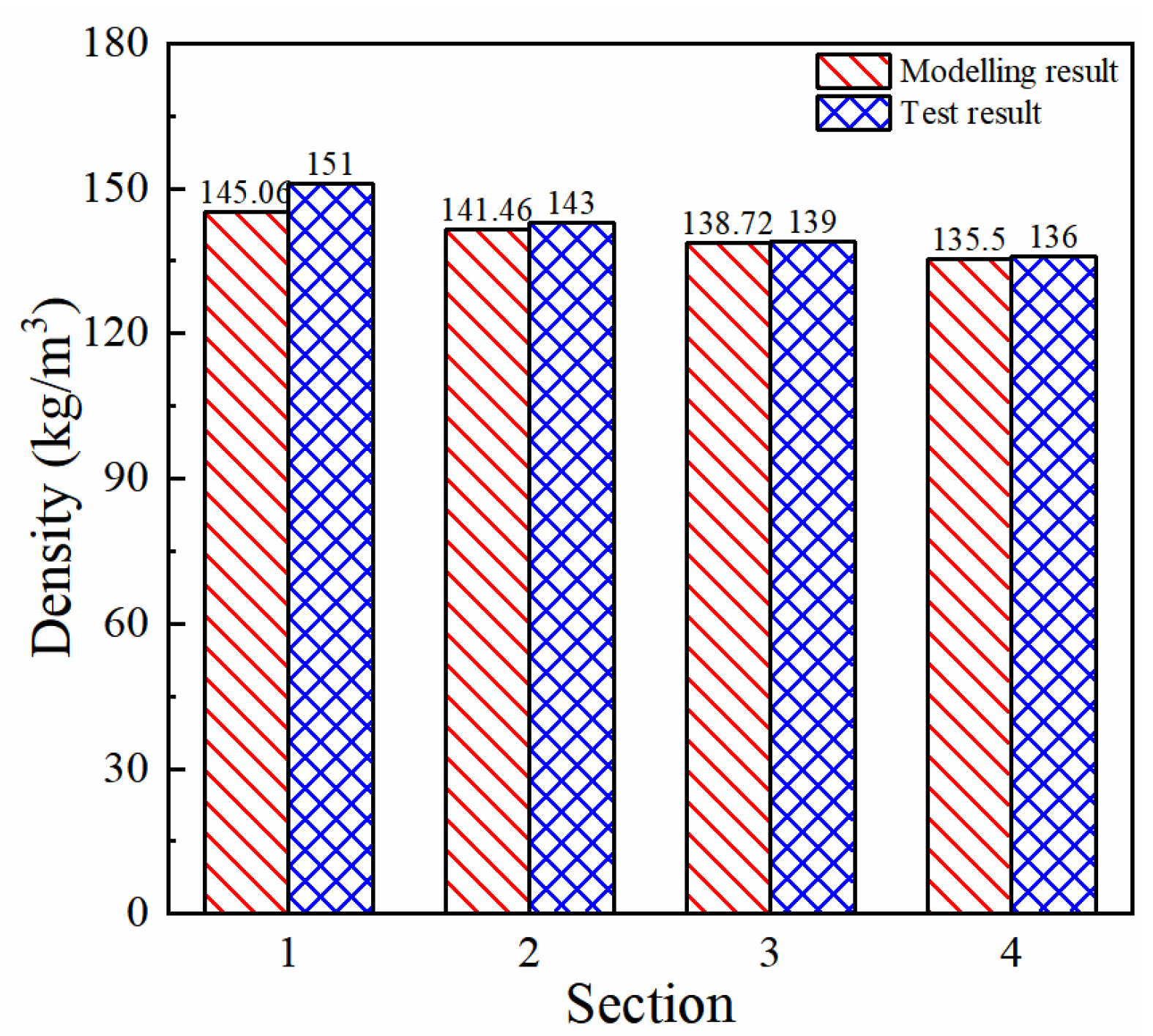



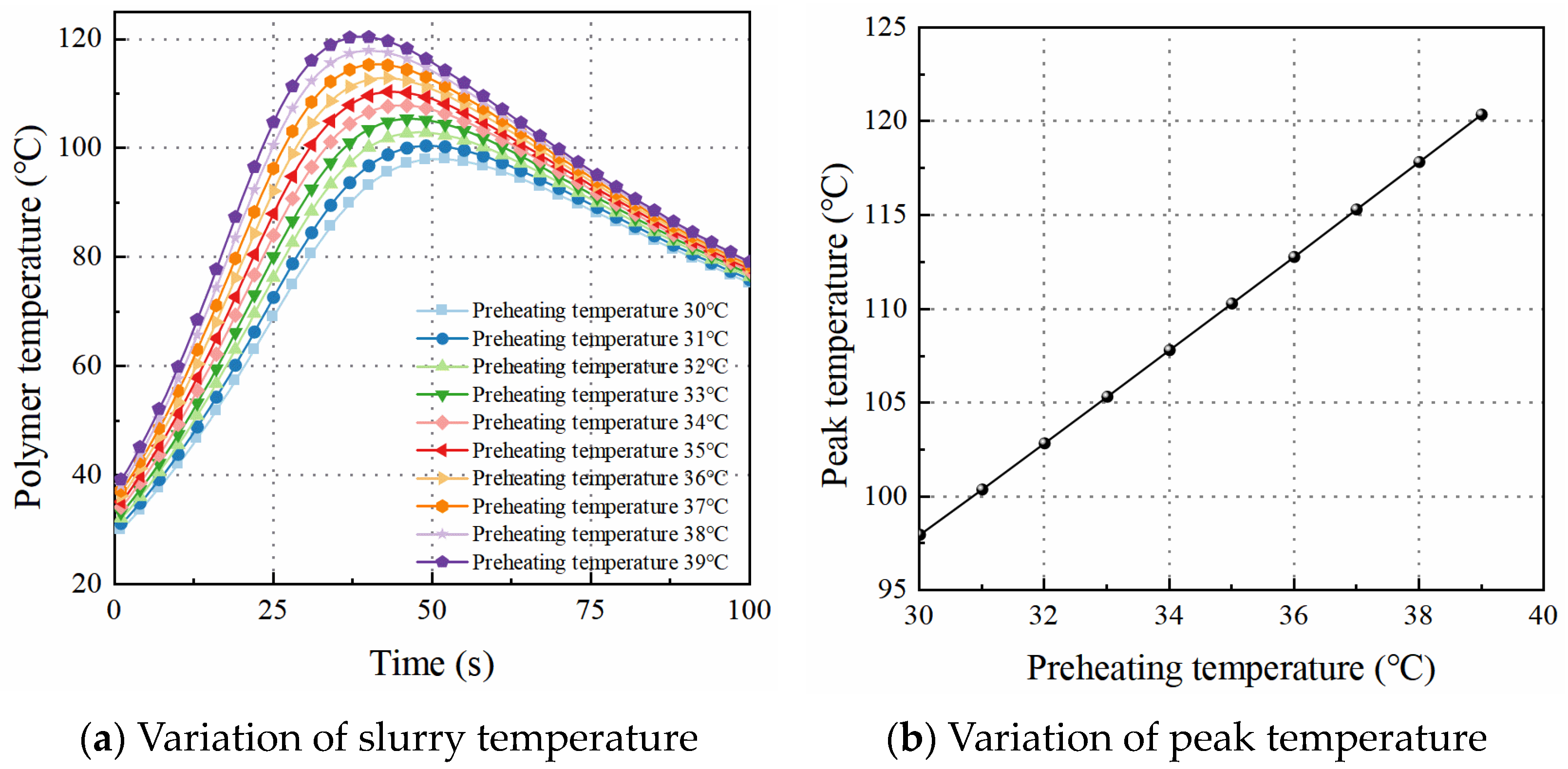
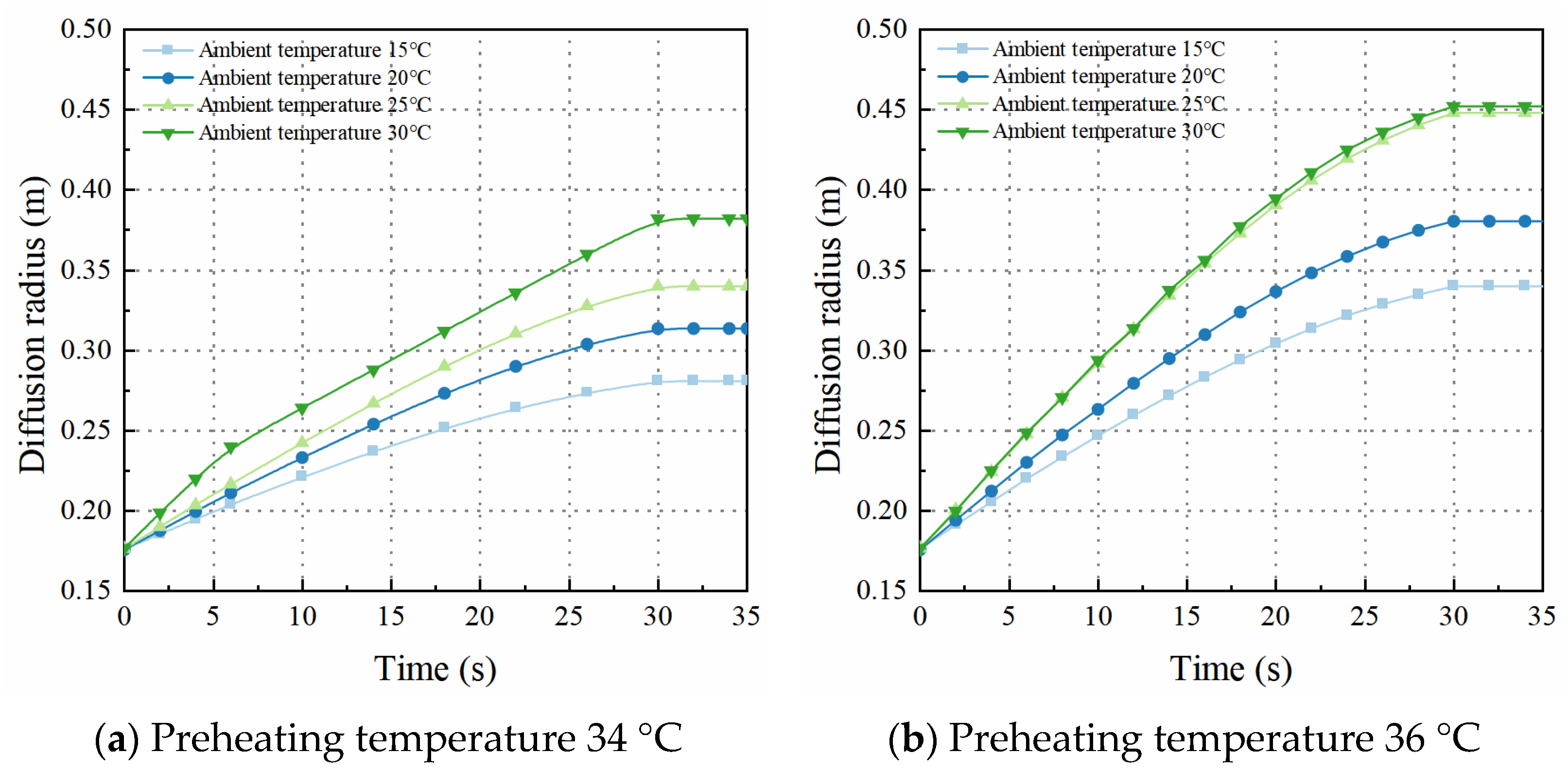
| Component | Ingredient | Mass Fraction Ration |
|---|---|---|
| Component A | Polymethylene polyphenyl polyisocyanate | 100% |
| Component B | Hard foam polyether polyol system | 50% |
| Additive flame retardant | 10% | |
| Catalyst system | 2% | |
| Surface active agent | 0.5% | |
| Physical blowing agent | 5% | |
| Chemical blowing agent | 0.5% | |
| Others | 32% |
| CRKP | Searching Space | Inversion Value | |
|---|---|---|---|
| Minimum Value | Maximum Value | ||
| AOH (m3·s−1·mol−1) | 2.3 | 3 | 2.628 |
| EW (J·mol−1·k−1) | 30,000 | 34,000 | 32,450.557 |
| AOH (m3·s−1·mol−1) | 25.676 | 29.676 | 27.457 |
| EW (J·mol−1·k−1) | 37,410 | 41,000 | 39,375.422 |
| Parameter | Parameter Value | Parameter | Parameter Value |
|---|---|---|---|
| AOH | 2.7029 m3·s−1·mol−1 | (ΔH)W | 8.6 × 104 kJ/kg |
| AW | 26.54 m3·s−1·mol−1 | (ΔH)BG | 20.68 × 104 kJ/kg |
| EOH | 35,195.707 m3·s−1·mol−1 | CP | 1800 J/kg·K |
| EW | 42,046.74 m3·s−1·mol−1 | CCO2 | 836.6 J/kg·K |
| cOH,0 | 4079.6 mol/m3 | CW | 294.7 J/kg·K |
| cNCO,0 | 4557.7 mol/m3 | CBG | 1000 J/kg·K |
| cW,0 | 294.7 mol/m3 | CBL | 1159 J/kg·K |
| ρS | 1890 kg/m3 | CS | 1680 J/kg·K |
| ρP | 1100 kg/m3 | R | 8.314 J/(mol·K) |
| ρBL | 1228 kg/m3 | μ | 1 Pa·s |
| ρW | 1000 kg/m3 | kS | 0.2 W·(m·K)−1 |
| (ΔH)OH | 7.705 × 104 kJ/kg | r0 | 17.6 cm |
Disclaimer/Publisher’s Note: The statements, opinions and data contained in all publications are solely those of the individual author(s) and contributor(s) and not of MDPI and/or the editor(s). MDPI and/or the editor(s) disclaim responsibility for any injury to people or property resulting from any ideas, methods, instructions or products referred to in the content. |
© 2023 by the authors. Licensee MDPI, Basel, Switzerland. This article is an open access article distributed under the terms and conditions of the Creative Commons Attribution (CC BY) license (https://creativecommons.org/licenses/by/4.0/).
Share and Cite
Jia, H.; Wang, F.; Li, X.; Gui, Y.; Zhong, Y.; Zhang, B. Experimental and Numerical Studies of Self-Expansible Polyurethane Slurry Diffusion Behavior in a Fracture Considering the Slurry Temperature. Sustainability 2023, 15, 8563. https://doi.org/10.3390/su15118563
Jia H, Wang F, Li X, Gui Y, Zhong Y, Zhang B. Experimental and Numerical Studies of Self-Expansible Polyurethane Slurry Diffusion Behavior in a Fracture Considering the Slurry Temperature. Sustainability. 2023; 15(11):8563. https://doi.org/10.3390/su15118563
Chicago/Turabian StyleJia, Heyang, Fuming Wang, Xiaolong Li, Yunxiang Gui, Yanhui Zhong, and Bei Zhang. 2023. "Experimental and Numerical Studies of Self-Expansible Polyurethane Slurry Diffusion Behavior in a Fracture Considering the Slurry Temperature" Sustainability 15, no. 11: 8563. https://doi.org/10.3390/su15118563





